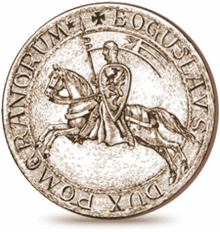Bogislaw II (Pomerania)

Bogislaw II (* around 1177 - 23 January 1220 ) was Duke of Pomerania .
Life and accomplishments
Bogislaw II. Stood together with his brother Casimir II. , Since their father Bogislaw I died while they were still a minor in 1187, under the tutelage of their mother Anastasia and Wartislaws II. Of Stettin , from the branch line of the Swantiboriden, which is stated in the documents is called Landvogt or vicedominus terrae.
After unsuccessful attempts to renounce Danish sovereignty, the duchess mother and her sons had to go to Denmark to personally get her fief from the hands of King Knut VI. to recieve. The Danish influence subsequently also asserted itself in the fact that in the war with Jaromar von Rügen the latter was appointed guardian and administrator in place of Wartislaw and Pomerania lost the disputed area of Wolgast and Loitz through the decision to Nyborg. The war waged by the dukes in 1209 against Jaromar and the city of Stralsund , which flourished under his protection, remained equally unsuccessful ; Finally, however, the border disputes between the two neighboring countries were settled at a diet in Denmark in 1216, and the feudal connection with this empire was also strengthened by a marriage between Kasimir and the Danish princess Ingardi.
In the battle that broke out soon after between Brandenburg and Denmark, Margrave Otto II defeated the Danish army under Peter von Roeskilde and also conquered Pomerania, but was unable to maintain the latter permanently; Rather, the duchy remained under Danish sovereignty, especially since during the throne dispute between the Hohenstaufen Philipp and the Welf Otto King Waldemar II took possession of all of northern Germany and, as ruler of the Danes , Slavs , Jutes and northern Albingians, raised the power of Denmark to the summit. This occupation even received recognition of the German Empire; because while the Guelph Emperor Otto IV zu Weißensee in Thuringia allied himself with Albrecht II of Brandenburg, from now on King Waldemar turned to the Hohenstaufen throne and received the enfeoffment from Friedrich II in Metz (1214) with papal confirmation all of the German and Slavic areas on the other side of the Elbe and Elde, which he also victoriously maintained against the Brandenburg attacks in association with the Pomeranian dukes.
After peace was established between Pomerania and Rügen through this defense and the adjustment of the border in 1216, Pomerania also began to gain strength and flourish again: not only was the rule of the dukes in Gützkow and Demmin secured, but also through the immigration of German colonists and that Eldena Monastery, founded by Joromar at the beginning of the 13th century, significantly promoted the country's culture. The presence of Bishop Christian , who led the renegade Prussians back to Christianity , was of great importance for the church in Pomerania. With his help, the dukes renewed the deserted Dargun monastery and received the decrepit Camminer Bishop Sigwin in 1219 in the cathedral provost Konrad a strong successor. Bogislaw also joined the crusade against the Prussians. After Casimir died on a train to Palestine in 1217 , Bogislaw II led a peaceful government alone for several years until his death and, according to the legend, was buried in Keniz, the border castle he built on the Oder against the Märker .
Marriage and offspring
Bogislaw II was married to Miroslawa , a daughter of Duke Mestwin I of Pomerania. From this marriage:
- Barnim I. (* around 1210; † 1278)
- Woislawa († 1229)
- Dobroslawa ∞ NN from Gützkow
literature
- Adolf Häckermann : Bogislav II. In: General German Biography (ADB). Volume 3, Duncker & Humblot, Leipzig 1876, p. 41 f.
Footnotes
- ↑ Martin Wehrmann : History of Pomerania . Vol. 1, Weltbild Verlag 1992, reprint of the 1919 and 1921 editions, ISBN 3-89350-112-6 , pp. 84–86.
- ^ Martin Wehrmann : Genealogy of the Pomeranian ducal house. Leon Sauniers Buchhandlung Verlag, Stettin 1937, p. 44.
| personal data | |
|---|---|
| SURNAME | Bogislaw II |
| BRIEF DESCRIPTION | Duke of Pomerania |
| DATE OF BIRTH | around 1177 |
| DATE OF DEATH | January 23, 1220 |
